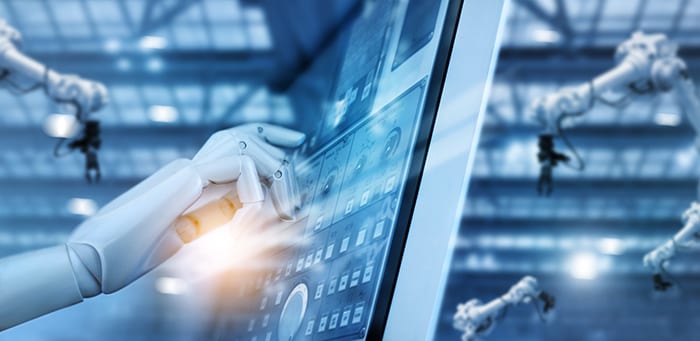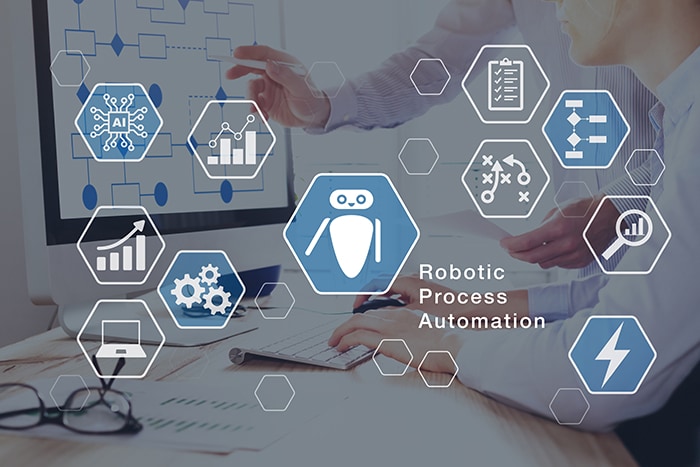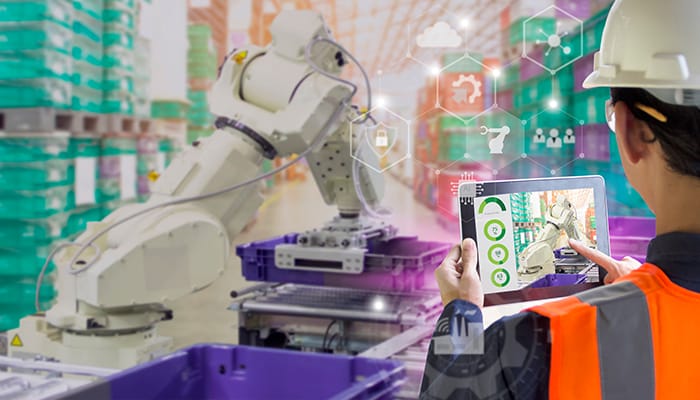Democratizing Automation with RPA and AI

Image Source: PopTika/Shutterstock.com
By Jeff Shepard for Mouser Electronics
Published September 16, 2021
Robotic Process Automation (RPA) is a software technology that simplifies the deployment and management of robots. RPA is sometimes called no code or low-code automation. It’s designed to enable users and operators to directly develop and use robotic applications and processes without relying on the assistance of software engineers. In addition to democratizing the development of robot platforms, the new RPA tools can be easier to scale across an organization.
RPA consists of two branches. Initially, RPA was used to develop software robots that emulate human actions interacting with digital systems and software. Many industries currently use these software bots in finance, compliance, legal, customer service, operations, and more. More recently, RPA has been extended to include the training and use of collaborative robots (cobots) on the factory floor and in warehouses.
Using RPA, a company can automate its entire workflow, infrastructure, backend processes, even manufacturing, logistics, and warehousing operations (Figure 1). Combining RPA with artificial intelligence (AI) and machine learning (ML) creates intelligent process automation (IPA) that can amplify the benefits. For example, an operator can set up a software bot or cobot for a given task using RPA. Then AI and ML can optimize performance over time.

Figure 1: RPA can support backend office automation and manufacturing, logistics, and warehousing activities. (Source: Mari Kova/shutterstock.com)
The urgency and need for automation technologies, such as RPA, AI, ML, and IPA, is stronger now than ever. Automation often requires extensive human participation and support. Democratization of automation gives companies the tools needed to automate mundane tasks and empower non-tech users. However, every new approach comes with challenges, and the democratization of automation is no different. By developing and following a systematic framework, businesses can address such complicacies with ease. The following looks at the use of software robots to automate digital systems. It then delves into how RPA can optimize the use of cobots. It closes by looking at the common challenges that arise when implementing RPA and presents some possible solutions.
What’s a Software Bot?
A software bot completes one or more tasks that humans previously performed. RPA tools enable individual users to create software bots using forms, drag-and-drop, and similar interfaces with no coding required. Before COVID-19, most RPA projects focused on automating routine tasks such as generating standard reports, logging into websites, checking forms for completeness, and transferring files (Figure 2). Web crawlers are an example of early software bots. RPA can now automate revenue-producing and customer-facing processes.

Figure 2: RPA was initially used to automate various back-office activities ranging from checking forms for completeness to generating standard reports. (Source: NicoElNino/shutterstock.com)
RPA software bots are rule-based and don’t learn. With software bots performing tedious and repetitive tasks more quickly and efficiently, humans are empowered to spend more time on creative and analytical activities. One of the challenges when deploying RPA in an organization is identifying which tasks or processes offer the best return on investment (ROI). That’s where process mining and process discovery can be leveraged.
Process Mining vs. Discovery
Process mining and process discovery are both implemented using specialized software bots. Process mining bots read event logs on computer networks to extract and map business process information. Process mining ignores user-level activities and cannot capture all of the nuances of user interactions. Process mining involves the extraction of data but does not perform analysis. It is often used in combination with process discovery.
Process discovery is a newer technology developed to run on individual user computers and monitor activities, collecting data on how the users perform specific tasks. Process discovery is concerned with how specific processes are executed. Process discovery bots record human work and use computer vision, neural networks, and AI/ML to create a metamodel. The metamodels provide a fast, reliable, and cost-effective way to identify processes best-suited for RPA. Process discovery observes and collects nuances that could easily be missed during the traditional method of shadowing an employee to understand how tasks are performed. The use of process mining and process discovery also enhance transparency and can protect privacy and eliminate personal bias.
Cobots and RPA
RPA is used with cobots to automate processes in factories and warehouses with small batch sizes and/or frequent tool changes. As with software bots, using RPA with cobots can eliminate time-consuming, monotonous, and unpleasant process steps and improve productivity. RPA can enable the use of a single cobot across a range of processes, increasing the cost-effectiveness of having cobots, especially for small- to medium-sized businesses.
In addition, cobots are often small and lightweight and easy to move around the facility. RPA makes them easy to reprogram and redeploy. Examples of cobot tasks suited to RPA include:
- Pick and Place can cover various activities from loading machines such as automated welders to packaging and palletizing in warehouse and logistics operations. Cobots also can provide more precise movements and handle larger weights compared with human operators.
- Process Finishing activities tend to be repetitive tasks. Many finishing processes require large amounts of force that cobots can consistently supply without fatigue. Cobots also can provide delicate motions when needed.
- Quality Control and Inspection can be implemented with cobots using high-resolution cameras. The images can be compared with reference images or computer-generated models of ideal parts. With RPA, these cobots can be reprogrammed easily and often, ensuring high levels of quality even from small batch processes.
Cobot programming has two primary RFA approaches. Some cobot makers have developed built-in RPA support and no-code development interfaces. In other instances, specialist companies are developing suites of no-code and low-code development environments that can be used with cobots from different robot makers. In addition, an open-source RPA community has emerged.
Cobot programming using RPA tools is implemented in various ways, such as (Figure 3):
- Physically moving the cobot arm(s) from position to position to create the program.
- Using a stylus to trace the cobot arm(s) required path and identify actions that need to take place at specific locations.
- Intuitive graphical user interfaces (GUIs) with drag-and-drop or point-and-click features.

Figure 3: Cobot programming using RPA tools can be implemented using a stylus to trace the path for the robot to follow, physically moving the robot arm from position to position, and with GUIs. (Source: PaO_STUDIO/shutterstock.com)
RPA’s Strength Can Be a Weakness
Democratization of automation is RPA’s strength. RPA is good at developing software bots for the automation of rules-based routine tasks. It is not suitable for supporting processes that need to adapt to changes or create agile environments. Organizations need to have clearly stated objectives and requirements for RPA deployments. For example, RPA might not be suited in applications:
- That have a minimal operational impact.
- With processes that change frequently.
- With activities or processes that cannot be completely rules-based.
- That require complex processes with multiple sub-processes.
- That require cognitive actions and frequent user intervention.
RPA is not a panacea. If employed without clear goals, objectives, and central coordination, it can result in isolated islands of automation developed by different groups and become a weakness. The existence of islands of automation can limit scalability and impact the long-term viability of RPA projects.
The lack of industry-wide RPA standardization is another factor that can lead to the development of automation islands. Each company should develop a comprehensive RPA strategy and implementation process. Traditional implementations of RPA to perform routine tasks can only impact the performance of those limited tasks and can suffer from other performance degradations as delineated above. RPA implementations can often benefit from integration into the larger organization through AI and ML use.
IPA to the Rescue
RPA is evolving and expanding. The addition of AI and ML to RPA deployments results in IPA bots that can assist human operators. In addition to the performance of simple rules-based tasks, IPA software bots can adapt, learn, or act unattended. IPA software bots can enable centralized coordination and the elimination of automation islands.
Simple RPA software bots efficiently perform clearly defined tasks, while IPA bots can learn how to perform or do a task better over time. The use of IPA bots can extend RPA capabilities into tasks that benefit from some level of cognitive ability, such as exception handling, natural language processing, and unstructured content extraction. IPA is expected to be essential to the continued expansion of RPA across larger portions of organizations. IPA software bots will enhance process flows and take on complex tasks that cannot be fully defined within a rules-based framework. IPA bots will be just as easy to program, maintaining the benefits of democratizing automation.
Summary
RPA is designed to democratize automation by enabling users and operators to directly develop and use robotic applications and processes without relying on the assistance of software engineers. It can be used to automate back-office activities as well as manufacturing, warehousing, and logistics processes. To maximize the return on investment and ensure scalability, RPA deployments need some level of central overview and control. As AI and ML capabilities are added to RPA, it morphs into more powerful, flexible, and scalable IPA technologies.